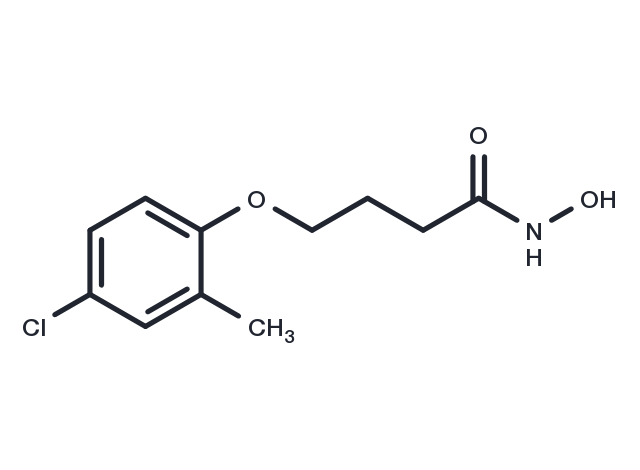Powder: -20°C for 3 years | In solvent: -80°C for 1 year


Droxinostat (NS 41080) is a selective inhibitor of HDAC, mostly for HDACs 6 and 8 with IC50 of 2.47 μM and 1.46 μM, greater than 8-fold selective against HDAC3 and no inhibition to HDAC1, 2, 4, 5, 7, 9, and 10.

| Pack Size | Availability | Price/USD | Quantity |
|---|---|---|---|
| 2 mg | In stock | $ 31.00 | |
| 5 mg | In stock | $ 46.00 | |
| 10 mg | In stock | $ 87.00 | |
| 25 mg | In stock | $ 185.00 | |
| 50 mg | In stock | $ 278.00 | |
| 100 mg | In stock | $ 413.00 | |
| 1 mL * 10 mM (in DMSO) | In stock | $ 47.00 |


| Description | Droxinostat (NS 41080) is a selective inhibitor of HDAC, mostly for HDACs 6 and 8 with IC50 of 2.47 μM and 1.46 μM, greater than 8-fold selective against HDAC3 and no inhibition to HDAC1, 2, 4, 5, 7, 9, and 10. |
| Targets&IC50 | HDAC6:2.47 μM, HDAC8:1.46 μM |
| In vitro | Droxinostat is originally identified as a sensitizer of PPC-1 cells to FAS and TRAIL by downregulating the expression of c-Fas-associated death domain-like interleukin-1-converting enzyme-like inhibitory protein (c-FLIP). [1] In PPC-1 cells cultured in suspension but not adherent conditions, Droxinostat (20 μM–60 μM) sensitizes cells to anoikis by initially activating caspase 8 with subsequent activation of the mitochondrial pathway. Similarly, Droxinostat also sensitizes other cancer cell lines including PC-3, DU-145, T47D, and OVCAR-3, but not LNCaP or MB-MDA-468, to anoikis or CH-11-induced apoptosis. [2] However, the direct targets of Droxinostat remains enigma until recently. It is revealed that in histone deacetylases (HDAC) isoform 1-10, Droxinostat selective inhibits HDAC3, 6, and 8, with IC50 values of 16.9 μM, 2.47 μM, and 1.46 μM, respectively, without inhibiting other HDAC members (IC50 > 20 μM). [3] In MCF-7 breast cancer cells, Droxinostat (10 μM–100 μM) sensitizes cells to apoptosis by decreasing c-FLIPL and c-FLIPS expression, reducing cell survival, and inducing apoptosis. [4] |
| In vivo | In SCID mice models, Droxinostat (30 μM)-treated PPC-1 cells results in decreased distant tumor formation than untreated cells. [2] |
| Kinase Assay | HDAC Inhibition Assay: HDAC inhibition is assessed using the CycLex HDACs fluorometric assay according to the manufacturer's protocol and using crude nuclear extract from HeLa cells (principally HDAC1 and HDAC2). The relative activity is expressed as (fluorescence intensity of treated samples/fluorescence intensity of controls) × 100 |
| Cell Research | PPC-1 cells (1 × 104) are seeded overnight into 96-well flat-bottomed plates in 100 μL of medium containing 2.5% FCS. The next day, Droxinostat is added. CH-11 antibody (100 ng/mL) is then added and the cells are incubated for 24 hours before assessing cell viability by 3-(4,5-dimethylthiazol-2-yl)-2,5-diphenyltetrazolium bromide (MTT) dye reduction assay.(Only for Reference) |
| Synonyms | NS 41080 |
| Molecular Weight | 243.69 |
| Formula | C11H14ClNO3 |
| CAS No. | 99873-43-5 |
Powder: -20°C for 3 years | In solvent: -80°C for 1 year
H2O: < 1 mg/mL (insoluble or slightly soluble)
DMSO: 46 mg/mL (188.8 mM)
Ethanol: 46 mg/mL (188.8 mM)
You can also refer to dose conversion for different animals. More
bottom
Please see Inhibitor Handling Instructions for more frequently ask questions. Topics include: how to prepare stock solutions, how to store products, and cautions on cell-based assays & animal experiments, etc.
Droxinostat 99873-43-5 Apoptosis Chromatin/Epigenetic DNA Damage/DNA Repair HDAC HDAC3 hepatocellular carcinoma (HCC) NS41080 Histone deacetylases cancer inhibit NS-41080 NS 41080 HDAC6 HDAC8 Inhibitor histone deacetylase (HDAC) inhibitor
